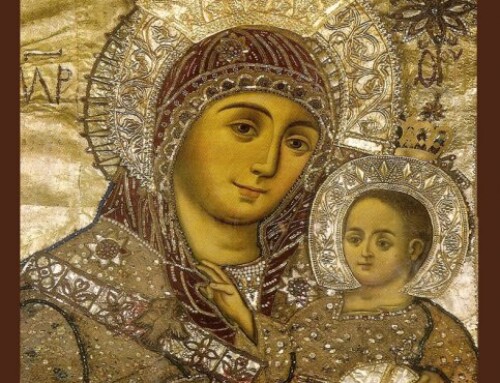Word Magazine June 1958 Page 5
CANDLES IN THE CHURCH
By Father David F. Abramtsov
St. George’s Church, Bridgeville
Everyone has observed the lights and candles that are used in all Orthodox churches and some, perhaps, have wondered at their significance.
First of all, let us look at the substance or matter of which these lights and candles are composed and which furnish us with such beautiful and pleasing light. In most Orthodox churches abroad and in many in this country the lamps which burn before the icons are filled with olive oil. In Greek the word of oil is synonymous with the word mercy. Just as oil can still troubled waters, so we sinners ought to be convinced of the fact that the mercy of God, in a quiet church, often shines in our hearts troubled with the cares of this world.
The candles we burn in church are made, or are supposed to be made, of beeswax, i.e., the wax secreted by bees for making honeycomb. These plain, slender tapers of wax tell of much which is interesting and of comfort to the devout Christian. Here we have a pure substance, gathered from different fragrant flowers in many fields and gardens throughout the landscape by one of the smaller creatures of God’s creation, which we offer to God in humble gratitude and acknowledgement of His dominion over all of His creation. A pure beeswax candle should remind us of purity in our way of life and that we ought to give up our entire life to Christ our God. Thus, candles are given to bridal pairs at weddings to symbolize the chaste life they led before marriage and the sinless life they ought to lead after marriage. The light of the candle reminds us that we are the “light of the world,” and that the Holy Spirit imparted to us in the Holy Sacraments ought to fill us with the warmth of faith.
Candles and lights have been used in the worship of God for thousands of years. In the early part of the Old Testament we are told that Moses “put the candlestick in the tent of the congregation … and he lighted the lamps before the Lord; as the Lord commanded Moses” (Exod. 40:24, 25). In the first days of the Church, Christianity was not tolerated by the Pagan world and Christians were obliged to assemble for public worship in catacombs, underground burial places, and in other secret spots. Since these hidden apartments, in many cases, did not admit the light of day the Faithful were obliged to have lights. One of the reasons for the present-day use of candles in church is in memory of these Orthodox forefathers of ours.
Candles, however, are used in our churches primarily for symbolic reasons. Thus, they help to signify that the Lord gives us the light of truth and that our souls ought to burn with the love of God and be penetrated through-out with feelings of joy and devotion. In accord with this conception, the lighting of the church is increased during the solemn services of Holydays (such as Christmas and Easter) and decreased during penitential services (such as evening services in Lent). St. Jerome, who lived fully 1500 years ago, wrote that “throughout all the churches of the East, when the Gospel is about to be read, tapers are lighted though it be broad daylight, not to scatter the darkness, but as a sign of joy. . .”
But there is still another reason why candles burn in our churches. They burn as offerings to the Lord. In the early days of the Church the Faithful brought offerings to the church in the form of beeswax, oil, wheat, wine, and other things. In modern times, for practical reasons, this kind of offering has been replaced with monetary contributions and with candle offerings. At the entrance of every Orthodox house of worship candles are made available for the worshippers to purchase and offer to the Lord. When worshippers enter the church to pray they purchase one or more candles and then themselves place the lighted candles on the candelabrum (candle stand) or some member of the parish board does this for them. Each time a candle is purchased an offering is made to the Lord. It also signifies that we have come to church to be enlightened in the spiritual and eternal truths of the Gospel: that we have come into the temple to pray as constantly and brightly as the candle which we have offered burns before the Holy Icons.
Some people have the mistaken notion that the candles placed at the entrance of the church are free for the taking. This is wrong for several reasons. First of all, the candles cost money. The parish must purchase the candles from some manufacturing firm and, depending on the type of candles bought and the quantity, these candles have cost the parish from 10ç to as high as 25ç each and for certain “Seven-day vigil candles,” much higher. To take a new candle without making a suitable offering, and most churches have fixed prices, is the same as stealing from the church. In a certain parish it became known that a pious lady was accustomed to taking three new candles every Sunday while making an offering of only five or ten cents! If everyone expressed their Orthodoxy in such a practical way the Church would soon be closed!
The second reason it is wrong to take candles without an offering is fairly obvious. The candle offering is an offering! It is not a taking! It is a giving and not a receiving situation. There is no offering involved if the parish church loses money. It would be like the ancient Christians coming to church empty-handed and taking home wheat, wine, and oil!


